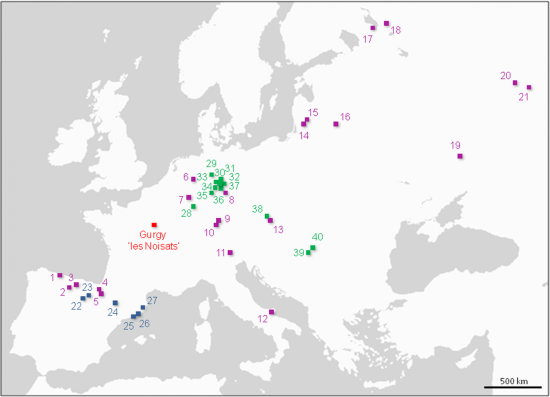When the Waves of European Neolithization Met: First Paleogenetic Evidence from Early Farmers in the Southern Paris Basin
Maïté Rivollat et al.
Source - http://journals.plos.org/plosone/article?id=10.1371/journal.pone.0125521
PLoS ONE 10(4): e0125521. doi:10.1371/journal.pone.0125521

Fig 1. Principal Component Analysis (PCA) on the ancient mtDNA dataset.
PCA performed with haplogroup frequencies and circle of correlation of the PCA. The ancient samples (S4 Table) included 'PRE_HG' for European Hunter Gatherers anterior to 4,000 BC (N = 41), 'PRE_Central_F' for Central European Neolithic farmers anterior to 4,000 BC (N = 147), and 'PRE_South_F' for Southern European Neolithic farmers anterior to 4,000 BC (N = 56). Some ancient groups anterior to 4,000 BC and sufficiently large enough for comparison at the population level are also shown (Derenburg, Halberstadt, Karsdorf, Salzmünde, from Germany [11,12,14,15]; and Los Cascajos from Spain [19]). doi:10.1371/journal.pone.0125521.g001
An intense debate concerning the nature and mode of Neolithic transition in Europe has long received much attention. Recent publications of paleogenetic analyses focusing on ancient European farmers from Central Europe or the Iberian Peninsula have greatly contributed to this debate, providing arguments in favor of major migrations accompanying European Neolithization and highlighting noticeable genetic differentiation between farmers associated with two archaeologically defined migration routes: the Danube valley and the Mediterranean Sea. The aim of the present study was to fill a gap with the first paleogenetic data of Neolithic settlers from a region (France) where the two great currents came into both direct and indirect contact with each other. To this end, we analyzed the Gurgy 'Les Noisats' group, an Early/Middle Neolithic necropolis in the southern part of the Paris Basin. Interestingly, the archaeological record from this region highlighted a clear cultural influence from the Danubian cultural sphere but also notes exchanges with the Mediterranean cultural area. To unravel the processes implied in these cultural exchanges, we analyzed 102 individuals and obtained the largest Neolithic mitochondrial gene pool so far (39 HVS-I mitochondrial sequences and haplogroups for 55 individuals) from a single archaeological site from the Early/Middle Neolithic period. Pairwise FST values, haplogroup frequencies and shared informative haplotypes were calculated and compared with ancient and modern European and Near Eastern populations. These descriptive analyses provided patterns resulting from different evolutionary scenarios; however, the archaeological data available for the region suggest that the Gurgy group was formed through equivalent genetic contributions of farmer descendants from the Danubian and Mediterranean Neolithization waves. However, these results, that would constitute the most ancient genetic evidence of admixture between farmers from both Central and Mediterranean migration routes in the European Neolithization debate, are subject to confirmation through appropriate model-based approaches.

Fig 3. Location of the sites anterior to 4000 cal BC.
PRE_HG (purple): 1) La Braña, 2) La Pasiega, 3) La Chora, 4) Erralla, 5) Aizpea, 6) Oberkassel, 7) Reuland-Loschbour, 8) Bad Durrenberg, 9) Hohleinstein, 10) Hohler Fels, 11) Villabruna, 12) Paglicci, 13) Dolni Vestonice, 14) Spiginas, 15) Donkalnis, 16) Kretuonas, 17) Uznyi Oleni Ostrov, 18) Popovo, 19) Kostenki, 20) Chekalino, 21) Lebyazhinka. PRE_South_F (blue): 22) Los Cascajos, 23) Paternanbidea, 24) Chaves, 25) Can Sadurni, 26) Sant Pau del Camp, 27) Avellaner. PRE_Central_F (green): 28) Flomborn, 29) Wittmar, 30) Oberwiederstedt, 31) Unterwiederstedt, 32) Salzmünde, 33) Derenburg, 34) Halberstadt, 35) Naumburg, 36) Karsdorf, 37) Esperstedt, 38) Vedrovice, 39) Szarvas, 40) Ecsegfalva. References in S4 Table. doi:10.1371/journal.pone.0125521.g003